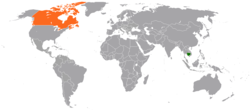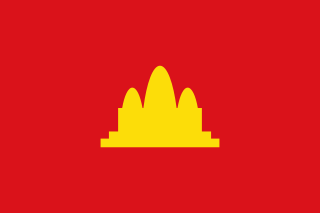
The Khmer Rouge is the name that was popularly given to members of the Communist Party of Kampuchea (CPK) and by extension to the regime through which the CPK ruled Cambodia between 1975 and 1979. The name was coined in the 1960s by then Chief of State Norodom Sihanouk to describe his country's heterogeneous, communist-led dissidents, with whom he allied after the 1970 Cambodian coup d'état.

Pol Pot was a Cambodian communist revolutionary, politician and a dictator who ruled Cambodia as Prime Minister of Democratic Kampuchea between 1976 and 1979. Ideologically a Maoist and a Khmer ethnonationalist, he was a leading member of Cambodia's communist movement, the Khmer Rouge, from 1963 to 1997, and served as General Secretary of the Communist Party of Kampuchea from 1963 to 1981. His administration converted Cambodia into a one-party communist state and perpetrated the Cambodian genocide which killed nearly 25% of Cambodia's population.

Phnom Penh is the capital and most populous city of Cambodia. It has been the national capital since the French protectorate of Cambodia and has grown to become the nation's primate city and its economic, industrial, and cultural centre. Before Phnom Penh became capital city, Oudong was the capital of the country.

Cambodia, officially the Kingdom of Cambodia, is a country in Mainland Southeast Asia. It borders Thailand to the northwest, Laos to the north, Vietnam to the east, and has a coastline along the Gulf of Thailand on the southwest. It spans an area of 181,035 square kilometres, and has a population of about 17 million. Its capital and most populous city is Phnom Penh.

Khieu Samphan is a Cambodian former communist politician and economist who was the chairman of the state presidium of Democratic Kampuchea (Cambodia) from 1976 until 1979. As such, he served as Cambodia's head of state and was one of the most powerful officials in the Khmer Rouge movement, although Pol Pot remained the General Secretary in the party.
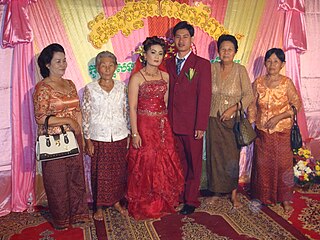
Chinese Cambodians are Cambodian citizens of Chinese ancestry or Chinese of full or partial Khmer ancestry. The Khmer term Khmer Kat Chen (ខ្មែរកាត់ចិន) is used for people of mixed Chinese and Khmer descent; Chen Khmer (ចិនខ្មែរ) means Cambodian-born citizen with ancestry from China. The Khmer constitute the largest ethnic group in Cambodia among whom Chen means "Chinese". Contact with the Chinese people such as envoys, merchants, travelers and diplomats who regularly visited Indochina verifiably existed since the beginning of the common era. However the earliest record of a Chinese community in Cambodia dates to the 13th century.

Democratic Kampuchea was the Cambodian state from 1975 to 1979, under the totalitarian dictatorship of Pol Pot and the Communist Party of Kampuchea (CPK), commonly known as the Khmer Rouge. It was established following the Khmer Rouge's capture of the capital Phnom Penh, effectively ending the United States-backed Khmer Republic of Lon Nol. After Vietnam took Phnom Penh in 1979, it was disestablished in 1982 with the creation of the CGDK in its place.

The People's Republic of Kampuchea (PRK) was a partially recognised state in Southeast Asia which existed from 1979 to 1989. It was a satellite state of Vietnam, founded in Cambodia by the Vietnamese-backed Kampuchean United Front for National Salvation, a group of Cambodian communists who were dissatisfied with the Khmer Rouge due to its oppressive rule and defected from it after the overthrow of Democratic Kampuchea, Pol Pot's government. Brought about by an invasion from Vietnam, which routed the Khmer Rouge armies, it had Vietnam and the Soviet Union as its main allies.

Cambodia was a farming area in the first and second millennia BC. States in the area engaged in trade in the Indian Ocean and exported rice surpluses. Complex irrigation systems were built in the 9th century. The French colonial period left the large feudal landholdings intact. Roads and a railway were built, and rubber, rice and corn grown. After independence Sihanouk pursued a policy of economic independence, securing aid and investment from a number of countries.
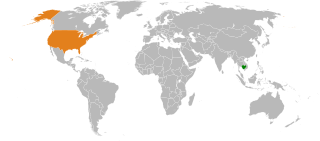
Bilateral relations between the United States and Cambodia, while strained throughout the Cold War, have strengthened considerably in modern times. The U.S. supports efforts in Cambodia to combat terrorism, build democratic institutions, promote human rights, foster economic development, eliminate corruption.
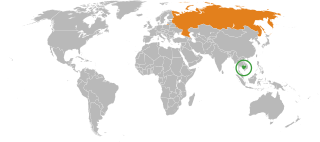
Cambodia–Russia relations are the bilateral relations of Cambodia and Russia. The relations between both countries were strong since the Soviet era. Russia has an embassy in Phnom Penh. Cambodia has an embassy in Moscow. Both countries are full members of the East Asia Summit.

The National Day of Remembrance, formerly called the National Day of Hatred, which falls on 20 May, is an annual event in Cambodia. It commemorates the Cambodian genocide of the Khmer Rouge regime that ruled the country between 1975 and 1979. It became a national holiday in 2018.

The 1997 Cambodian coup d'état took place in Cambodia from July to September 1997. As a result, co-premier Hun Sen ousted the other co-premier Norodom Ranariddh. At least 32 people were killed during the coup.

The Cambodia Securities Exchange is the national stock exchange of Cambodia. The exchange's purpose is to achieve high economic growth by facilitating flows of capital, investment, and reallocation of capital based on capital market mechanisms. The exchange is headquartered in the Canadia Tower, in Cambodia's capital city, Phnom Penh.

Cambodia–India relations, also known as Cambodian-Indian relations, are the bilateral relations between the Kingdom of Cambodia and the Republic of India. Cambodia has an embassy in New Delhi, and India has an embassy in Phnom Penh.

The Communist Party of Kampuchea (CPK), also known as the Khmer Communist Party, was a communist party in Cambodia. Its leader was Pol Pot, and its members were generally known as the Khmer Rouge. Originally founded in 1951, the party was split into pro-Chinese and pro-Soviet factions as a result of the Sino–Soviet split with the former being the Pol Pot faction, and the latter adopting a more revisionist approach to Marxism. As such, it claimed that 30 September 1960 was its founding date; it was named the Workers' Party of Kampuchea before it was renamed the Communist Party in 1966.

The Cambodian genocide was the systematic persecution and killing of Cambodian citizens by the Khmer Rouge under the leadership of Prime Minister of Democratic Kampuchea, Pol Pot. It resulted in the deaths of 1.5 to 2 million people from 1975 to 1979, nearly 25% of Cambodia's population in 1975.

Anti-government protests were a series of protests in Cambodia from July 2013 to July 2014. Popular demonstrations in Phnom Penh took place against the government of Prime Minister Hun Sen, triggered by widespread allegations of electoral fraud during the Cambodian general election of 2013. Demands to raise the minimum wage to $160 a month and resentment at Vietnamese influence in Cambodia have also contributed to the protests. The main opposition party refused to participate in parliament after the elections, and major demonstrations took place throughout December 2013. A government crackdown in January 2014 led to the deaths of 4 people and the clearing of the main protest camp.

Khmer nationalism is a form of nationalism found in Cambodia, that asserts that Khmers (Cambodians) are a nation and promotes the cultural unity of the Khmer (Cambodian) race.
The Embassy of France in Cambodia is the primary diplomatic mission of the French Republic to the Kingdom of Cambodia. It is located in the capital Phnom Penh. It is known for the role it played as a place of refuge for foreigners and at-risk Cambodians after the Khmer Rouge takeover for several days until foreigners were forced to go to Thailand while the regime forced Cambodians to stay in the country.
